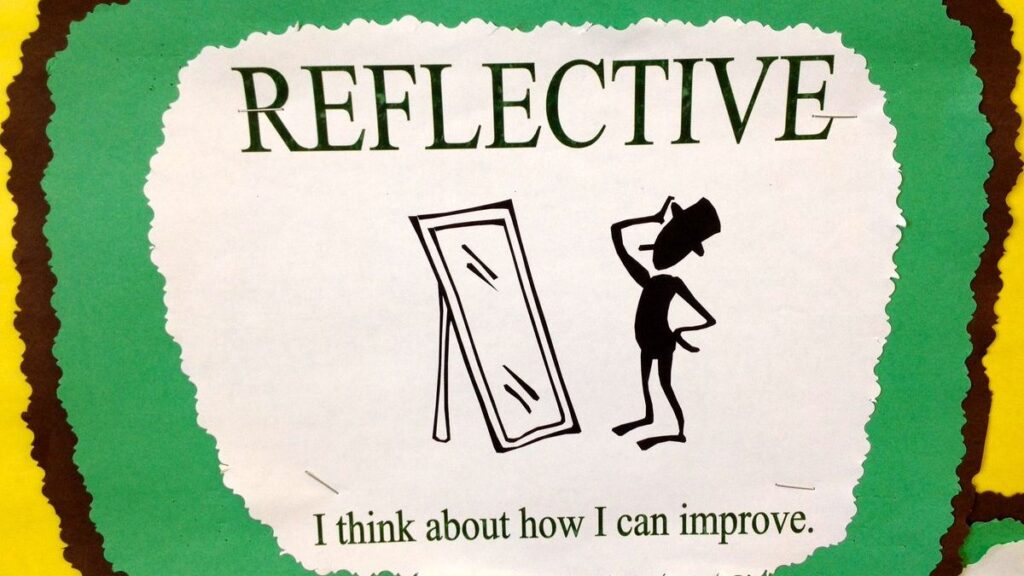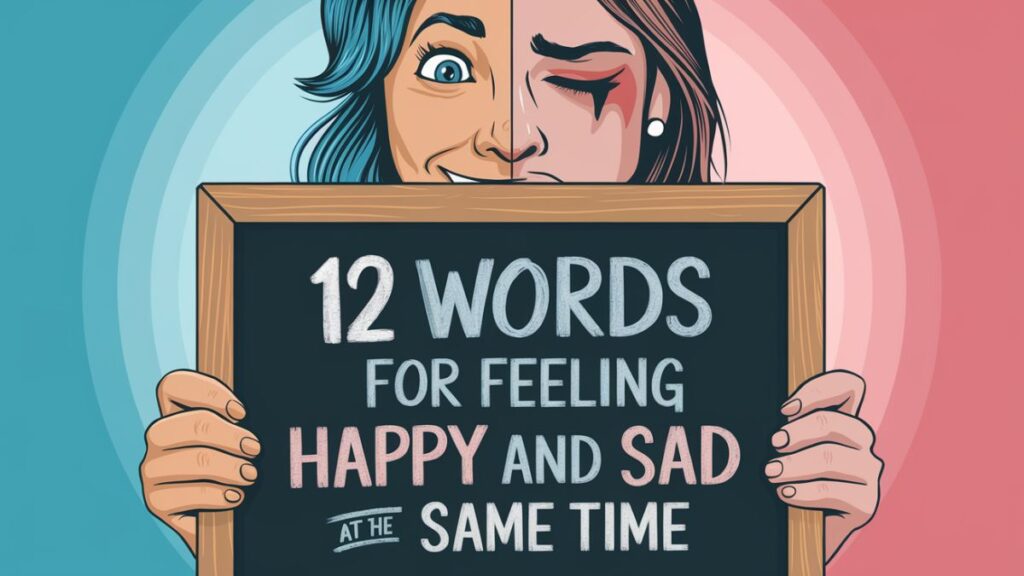Have you ever felt a strange mix of happiness and sadness at once? Maybe you experienced melancholic joy when looking at an old photo album, or nostalgic bliss when reminiscing about childhood. These emotions seem contradictory, yet they coexist, creating a unique emotional state that’s both profound and deeply human. This is why having 12 Words for Feeling Happy and Sad at the Same Time helps us describe these emotions with clarity and depth.
Language has a way of capturing even the most complex contentment, and throughout history, different cultures have coined words to express this paradox. In this article, we’ll explore 12 words for feeling happy and sad at the same time, their origins, meanings, and how they apply to everyday experiences.
Melancholic Joy
Melancholic joy is the happiness that carries a shadow of sadness. It’s the laughter that follows tears, the relief after a heartfelt goodbye, or the joy of hearing an old song that reminds you of someone you miss. This feeling is both beautiful and haunting, a mix of warmth and sorrow.
This emotion often appears in art and literature, where it adds depth to storytelling. Poets and novelists frequently capture melancholic joy in their work, using it to illustrate the complexity of human experience. It reminds us that even in the happiest moments, there can be a touch of loss.

Psychologists suggest that melancholic joy helps us process grief and change. By allowing happiness and sadness to exist simultaneously, we become more resilient. This emotional blending can even strengthen relationships, as shared experiences of loss and joy deepen connections between people.
Recognizing melancholic joy in daily life can make emotions feel richer and more meaningful. Instead of resisting sadness, embracing it alongside happiness allows for a more profound appreciation of life’s fleeting moments.
Nostalgic Bliss
Nostalgic bliss is the warmth of remembering past moments while knowing they are gone. It’s the joy of flipping through an old photo album, watching childhood cartoons, or hearing a song from a different era. The sweetness of these memories is tinged with a slight ache, a longing for what once was.
Nostalgia plays a crucial role in emotional well-being. Studies show that reminiscing about the past can improve mood, increase self-esteem, and foster a sense of continuity in life. While excessive longing for the past can lead to sadness, a healthy dose of nostalgia provides comfort and perspective.
Many cultures celebrate nostalgic bliss through traditions and storytelling. Family gatherings, holidays, and reunions often bring this emotion to the surface, allowing people to connect over shared memories. Even digital platforms contribute to this phenomenon, with “memory” features that bring back past moments.
While nostalgia reminds us of time’s passage, it also offers a sense of identity. By reflecting on where we’ve been, we better understand who we are, making nostalgic bliss an important part of self-discovery and emotional richness.
Complex Contentment
Complex contentment is a deep sense of satisfaction mixed with awareness of imperfection. Unlike simple happiness, which is immediate and pure, complex contentment comes with an understanding that nothing lasts forever. It’s finding peace despite struggles, fulfillment despite flaws.
This feeling is often associated with personal growth. When people reflect on past hardships and realize how far they’ve come, they experience complex contentment. It’s the satisfaction of overcoming challenges while acknowledging the difficulties faced along the way.
Many philosophical and spiritual traditions embrace this idea. In Buddhism, for example, contentment is linked to mindfulness—being at peace with what is, rather than wishing for what could be. In Western thought, stoicism teaches a similar lesson: embracing life’s ups and downs with equanimity.
Understanding complex contentment allows people to appreciate the present without needing perfection. It fosters resilience, helping individuals navigate life’s uncertainties with grace and wisdom.
Reflective Elation
Reflective elation is the joy that comes from deep introspection. It’s the thrill of realizing personal growth, the rush of self-discovery, or the quiet happiness of understanding life’s meaning. This emotion is uplifting yet thoughtful, a mix of excitement and contemplation.
Unlike fleeting happiness, reflective elation tends to be long-lasting. It comes from moments of clarity—when we see how past events shaped us, recognize our strengths, or find peace with our experiences. These moments often happen during quiet reflection or after significant life events.

Artists, writers, and philosophers frequently seek reflective elation. Creativity thrives in this emotional state, where deep thoughts mix with bursts of inspiration. The feeling of completing a meaningful project or gaining insight into a problem can bring this kind of joy. Words for Feeling Happy and Sad at the Same Time
Experiencing reflective elation encourages continuous learning and self-improvement. By embracing this feeling, people can navigate life with a greater sense of purpose, always striving for deeper understanding and personal growth.
Tender Sorrow
Tender sorrow is a gentle sadness, one that doesn’t overwhelm but lingers softly. It’s the quiet sadness of parting ways, the delicate ache of missing someone, or the bittersweet realization that time moves forward. Unlike deep grief, tender sorrow is light, carrying warmth within it.
This emotion often arises in moments of transition. Saying goodbye to a loved one, watching a child grow, or finishing a meaningful book can all bring tender sorrow. It acknowledges loss without despair, making it easier to carry.
In many cultures, this feeling is embraced rather than avoided. Traditional songs, poetry, and rituals often express tender sorrow, helping communities process emotions collectively. Mourning traditions, for example, allow people to grieve while still holding onto cherished memories. Words for Feeling Happy and Sad at the Same Time
Understanding tender sorrow allows for emotional acceptance. It teaches that sadness doesn’t always need to be resisted; sometimes, feeling it fully leads to greater appreciation of life’s beauty.
Poignant Happiness
Poignant happiness is a type of joy that carries a subtle undercurrent of sorrow. It’s the feeling of seeing an old friend after many years, knowing that time has changed you both. The happiness is undeniable, but it is tinged with the realization that moments like these are fleeting.
The word poignant comes from the Latin pungere, meaning “to sting.” This highlights the emotional complexity of the experience—it is a joy so deep that it almost hurts. This feeling often arises in nostalgia, where the sweetness of the memory is softened by the knowledge that it belongs to the past.
Poignant happiness can also be experienced in art, literature, and music. A beautifully written novel that ends on a hopeful yet sorrowful note, or a song that brings tears despite its uplifting melody, can evoke this powerful emotion. It reminds us that the most meaningful experiences are often those that stir multiple emotions at once.
Understanding and embracing poignant happiness can lead to a richer emotional life. Rather than resisting sadness, we can learn to see it as a natural counterpart to joy. This acceptance allows us to fully appreciate the depth and beauty of our experiences.
Bittersweet Ecstasy
Bittersweet ecstasy captures the feeling of intense joy that is shadowed by an underlying sadness. It’s the thrill of achieving a long-awaited goal, tempered by the realization that the journey is over. This emotional blend makes the happiness even more profound because it acknowledges the cost of reaching that moment.
This term is commonly associated with life’s major milestones. Graduating from college, getting married, or moving to a new country can all bring feelings of bittersweet euphoria. While these experiences are overwhelmingly positive, they also mark the end of an era, bringing a subtle sense of loss.

The contrast between the two emotions creates a unique kind of emotional high. In some ways, the presence of sadness enhances the happiness, making it feel more intense and meaningful. This phenomenon is often seen in storytelling, where moments of triumph are heightened by the struggles that preceded them.
Accepting bittersweet ecstasy as part of life’s emotional landscape allows us to embrace the full spectrum of human experiences. Rather than seeking pure happiness, we can appreciate the complexity of our emotions and the lessons they bring.
Ambivalent Delight
Ambivalent delight describes a feeling of joy mixed with uncertainty or doubt. It’s the excitement of starting something new while grappling with the fear of change. This feeling is common in transitional moments—starting a new job, moving to a new city, or even falling in love.
The word ambivalent comes from the Latin ambi- (both) and valere (to be strong). It suggests that both emotions—joy and hesitation—are equally powerful. This can make decision-making difficult, as we struggle to reconcile our excitement with our concerns.
Psychologists believe that ambivalence is a natural and even beneficial emotional state. It forces us to slow down and evaluate our choices carefully, leading to more thoughtful and intentional decisions. Rather than rushing into new experiences blindly, we learn to weigh the pros and cons with greater awareness.
Understanding ambivalent delight can help us navigate uncertainty with confidence. Instead of seeing doubt as a weakness, we can recognize it as a sign of deep thoughtfulness. This perspective allows us to embrace new experiences with a sense of balance and clarity.
Rueful Euphoria
Rueful euphoria is the paradox of feeling incredibly happy while simultaneously regretting something. It’s the exhilaration of taking a spontaneous trip, tinged with the knowledge that you’ve left responsibilities behind. This feeling reminds us that even our happiest moments can come with a price.
The word rueful stems from the Old English hreowan, meaning “to feel sorrow or regret.” Combined with euphoria, which means extreme happiness, it creates an emotional state that is deeply contradictory yet entirely human. Many people experience rueful euphoria when making impulsive choices, enjoying the thrill but also recognizing the consequences.
This emotional blend is frequently explored in films and literature. A character who finally achieves their dream but at great personal cost embodies rueful euphoria. The tension between joy and regret makes for powerful storytelling and deep character development.
Recognizing rueful euphoria in our own lives can help us make more mindful choices. By acknowledging both the highs and the potential downsides of our decisions, we can move forward with greater awareness and wisdom. Words for Feeling Happy and Sad at the Same Time
Tragicomic Serenity
Tragicomic serenity is a state of peaceful acceptance in the face of life’s contradictions. It is the feeling of laughing through tears, of finding comfort in irony, and of understanding that joy and sorrow often go hand in hand. This emotional state arises when we acknowledge life’s unpredictability and choose to embrace it with a mix of humor and grace.
This paradox is often seen in moments where pain and humor coexist. A comedian delivering a heartfelt yet humorous eulogy, a person reminiscing about a loved one with both laughter and tears, or someone finding solace in a bittersweet memory all embody tragicomic serenity. It is an understanding that life is neither entirely joyful nor entirely sorrowful but a blend of both.
In literature and film, this emotional state is frequently depicted in tragicomedy, a genre that merges elements of tragedy and comedy. Stories that make audiences laugh while evoking deep emotions create a connection to this duality. Shakespeare’s plays, for example, often blend humor with tragic elements, reflecting the complexity of human experience.
Understanding and embracing tragicomic serenity can lead to resilience and emotional growth. When we learn to balance joy and sorrow, we cultivate a perspective that allows us to navigate life’s ups and downs with grace. Instead of resisting negative emotions, we accept them as part of a richer, more meaningful existence.

Emotional Contradictions
Emotional contradictions occur when we experience two seemingly opposing feelings at the same time. These paradoxical emotions can arise in situations where joy and sadness intertwine, such as feeling grateful yet heartbroken after saying goodbye to a loved one or being proud but nostalgic when witnessing a child’s milestones.
One of the reasons emotional contradictions are so common is that human experiences are rarely one-dimensional. Our emotions are influenced by personal history, Words for Feeling Happy and Sad at the Same Timerelationships, and expectations, creating a complex tapestry of feelings. This is why a moment of success can feel both exhilarating and melancholic—because it often comes with change or loss.
Psychologists suggest that emotional contradictions help us process major life events. They allow us to acknowledge and validate our experiences without forcing emotions into rigid categories. Instead of labeling emotions as purely positive or negative, we can accept their fluidity, leading to better emotional regulation and mental well-being.
Recognizing emotional contradictions can also deepen our empathy and understanding of others. When we accept that people often feel multiple emotions at once, we become more compassionate listeners and supporters. This awareness enhances our relationships and helps us connect on a deeper, more authentic level.
Joyful Melancholy
Joyful melancholy is the feeling of happiness tinged with sorrow. It is the sensation of finding beauty in sadness, of feeling deeply connected to a moment while knowing it will soon pass. This emotion often surfaces in nostalgic memories, heartwarming goodbyes, and reflections on meaningful experiences.
A classic example of joyful melancholy is the experience of watching a child grow up. Parents feel immense pride and happiness witnessing their child’s achievements, yet they also mourn the passing of each stage. This mix of emotions makes the experience richer and more profound, highlighting the complexity of parental love.
Music and poetry frequently capture joyful melancholy. Songs that evoke nostalgia, lyrics that express both longing and gratitude, and poetry that intertwines joy with sadness all embody this emotion. Artists often draw from their own experiences of wistful joy to create works that resonate with others on a deep level.
Embracing joyful melancholy allows us to cherish the present moment while acknowledging its impermanence. Instead of fearing change, we can appreciate the beauty in transitions and the emotions they bring. This perspective enriches our lives, making each moment more meaningful and deeply felt. Words for Feeling Happy and Sad at the Same Time
Conclusion
Life is full of conflicting emotions, and having the right words helps us express them. Whether you experience reflective bliss or somber elation, embracing these feelings adds richness to your human experience.
So next time you feel a wave of tender sorrow, remember—you’re not alone. The language of mixed emotions connects us all.

Jenni Maic is a creative wordsmith at Grammar Globe, where she brings humor and wit to the world of puns and English grammar. With a passion for playful language and a knack for simplifying grammar, Jenni’s articles make learning engaging and entertaining. Discover her work at https://grammarglobe.com/.






